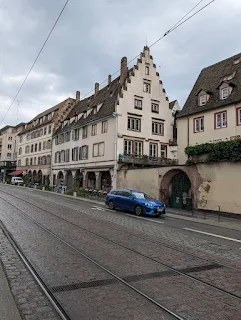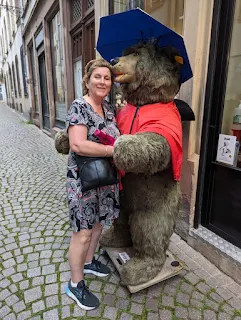I’d noticed on the brochure we’d received from the Tourist Information centre that Strasbourg had a palace that might be worth visiting. The Rohan Palace was the residence of the Prince-Bishops and Cardinals of the House of Rohan, an ancient French noble family from Brittany. It was completed in the 1742 and is considered a masterpiece of French Baroque architecture. Many notable people have lived there or visited there including Louis XV, Charles X, Marie Antoinette, Napoleon Bonaparte, his wife Josephine and, now, the Smiths of Maiden Gully.
The Palace sits between the Strasbourg Cathedral and the River Ill. It’s deceptively large. Since the 19th century it has been the home of three of Strasbourg’s most important museums – the Archaeological Museum, the Museum of Decorative Arts and the Museum of Fine Arts. Each of these museums is quite extensive in their own right so that gives you an idea of how large the Palace is. We fronted up to the ticket office the idea that we’d visit the Archaeological Museum only (Greg’s idea). After a brief conversation with the lady behind the glass we learned that there was a Senior's ticket available to anyone over 60! For €8:00ea we could visit all three museums on site, plus the special temporary exhibition currently running and a dozen other places around Strasbourg. Good to see the old folks being looked after again! We had 24hrs to visit them all. After putting the back-pack in the free locker we head to the basement to view the Archaeological Museum. The museum started with displays of artefacts from pre-historic times that had been uncovered in the region of Alsace. Each display was accompanied by a very detailed description of where it sat in the timeline of history, what it was used, by whom and some information about its discovery. Bones and fossils of the pre-historic fauna that roamed the region were prominent in the presentation. Kerry was particularly absorbed by the almost complete skeletons of human-kind that were displayed lying in their “grave” under the perspex floor. After 45 minutes we left the museum with not yet all of it fully explored.
All the museums in Strasbourg shut at 1:00pm for an hour for lunch so we wanted to make sure we were able to spend enough time in the remaining two museums. Back up to the ground floor we went and entered the hard-to-find door into the Decorative Arts Museum. Behind the door we found not the Decorative Arts Museum but the State Rooms of the Prince-Bishops and their guests. This what what we really wanted to see. As you might imagine the rooms are all enormous and elaborately decorated in the Baroque style. Tall windows that faced the river one side or the inner courtyard on the other let in plenty of light. The ceilings were so high that they really enhanced the size and the space of each room. Lavish tapestries and large paintings adorned every wall and, of course, the classic white painted walls with intricate gold detailing was present wherever one looked. Apart from the vast Synod Hall into which one enters the Apartments of State, the two adjacent bed-chambers of the King, one large and one small, stood out. Not so much because of the furnishings or the paintings but because, when you stop for a moment to think, of the who actually have slept there in the centuries past.
We poked our head into the Decorative Arts Museum half-way through the tour of the State Apartments and then moved along to the Fine Arts Museum. Our glance revealed decorated pieces of fine earthenware and the like. We’d still be there if we’d given that one a thorough visit. To my surprise Kerry was not so interested to visit it. The bulk of the work in the Fine Arts Museum is, not surprisingly, of a religious nature. Like in the other museums the display is very extensive covering many different ages and style from nay different artists. Lots of the baby Jesus, the Virgin Mary and Christ crucified. Lots of semi-naked women as well. Towards the end the art became more a reflection of peoples normal lives during the 18th-19th centuries, which I found much more interesting. BTW, the museum ticket also comes with a free audio guide which we availed ourselves of in the Apartments of State.
After a really worthwhile couple of hours spent, and just before the lunch bell rang, I grabbed our back-pack and we went to find some lunch for ourselves. A cafe/bar we’d been to twice before called La Platz in the square in front of the Cathedral won our business again. The seats offer a brilliant view of the Cathedral and the young waiter there offers brilliant service so why wouldn’t we go back there for a third time? On our first visit he miss-heard our request for mineral water mit gaz and bought us a bottle of still water instead. It took it back to fix the problem and although you could see he was just a little annoyed he replaced it without protest and continued to give us good service. So we went back and we went back again and he got a tip (which I rarely do voluntarily) on each of our visits. Anyway, we ordered a savoury flambée, a local dish of two cheeses, onion and bacon pieces on a super-thin crust. Delicious!
From here we walked towards Kléber Square to meet with the guide of our free walking tour. On the way we passed a jewellery store in a shady square adjacent to Temple Neuf where she found a lovely pair of navy blue earrings. Can’t be anything wrong with anything that’s Navy Blue! We met our guide Halima, a bright young Italian girl whose been living in Strasbourg for five years. Our group was very small, just us and two other girls a little young than us. Halima walked us around all the major sights of Strasbourg, many of which we’d already visited but now we had some additional and valuable insights. Many of things I learned from Halima on our tour I’ve incorporated in the words above. After about 2.5 hrs, with her enthusiasm never flagging, Halima said goodbye to us on the Pont Saint-Martin. We stopped for a drink a nearby bar and then headed home for the day.




















No comments:
Post a Comment